Examining and Survey Historic Icons
Christian icons, revered as sacred images of Christianity and as masterpieces as historical artworks, have transcended centuries, serving as powerful expressions of faith and repositories of theological teachings.
Despite their spiritual significance, icons are vulnerable to the ravages of time, enduring environmental factors, human intervention, and natural disasters that threaten their integrity. The conservation and restoration of these icons demand not just specialized knowledge and skills, but also a profound sensitivity to their religious and cultural importance.
The expertise and precision of professional expert icons conservators and restorers are indispensable in preserving these invaluable artefacts. This article illuminates the meticulous journey of conserving and restoring Christian icons, emphasizing the crucial role of skilled professionals in safeguarding these delicate treasures. Through a harmonious blend of scholarly research, advanced scientific techniques, and artistic finesse, these experts ensure that the icons’ authenticity and cultural significance endure, remaining intact for generations to come.
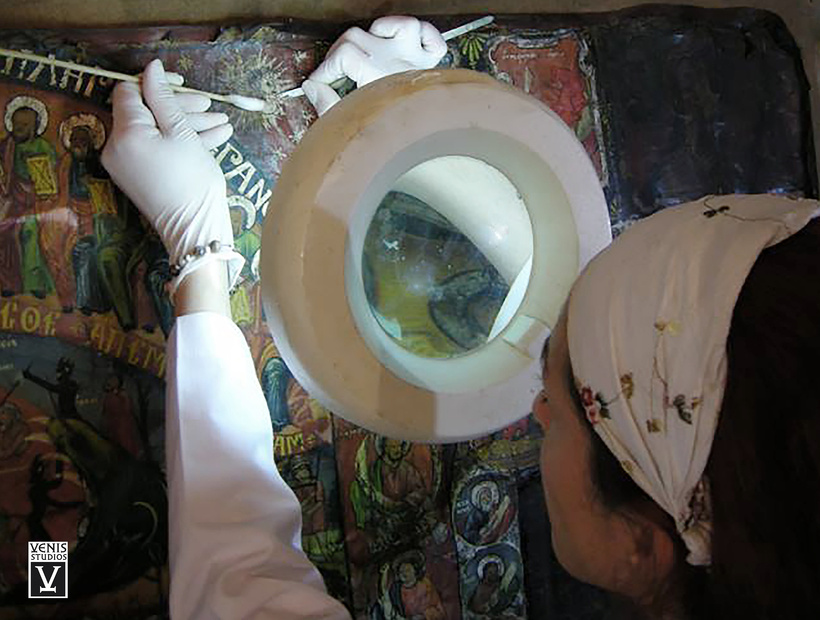
©VENIS STUDIOS
The meticulous examination and analysis of icons constitute an indispensable phase in the conservation and restoration process. This critical step helps identify the materials, techniques, and historical context of the icons, enabling conservators to make informed decisions. Various methods, meticulously tailored to specific requirements, are employed in this endeavour:
Examination and survey methods of paint layers on icons involve various techniques that provide valuable insights into the composition, condition, and history of the artworks. Here’s an overview of the methods commonly used in the analysis of paint layers on icons:
-
Visible Spectra Examination
-
Microscopic Examination
-
Infrared Reflectography (IR)
-
Ultraviolet (UV) Examination
-
Reflectance Transformation Imaging (RTI)
-
X-ray Röntgen
-
Spectroscopic Techniques
-
Scanning Electron Microscopy (SEM)
Documentation of Icons
In the comprehensive process of conserving and researching an icon, a systematic documentation methodology is followed:
Historical Research involves gathering information about the icon’s origin, provenance, and historical significance through consultation with historical records and relevant literature. Visual Examination is conducted, meticulously documenting surface irregularities, paint layers, damages, and inscriptions through photographs and written descriptions under various lighting conditions. Material Analysis employs scientific techniques like X-ray fluorescence and Fourier-transform infrared spectroscopy to identify the icon’s materials.
Documentation Photography captures high-resolution images, ensuring a comprehensive visual record of the icon’s condition. Condition Assessment evaluates the overall condition, noting damages, discolouration, or alterations. Previous Restoration Work is investigated, documenting methods, materials, and their impact.
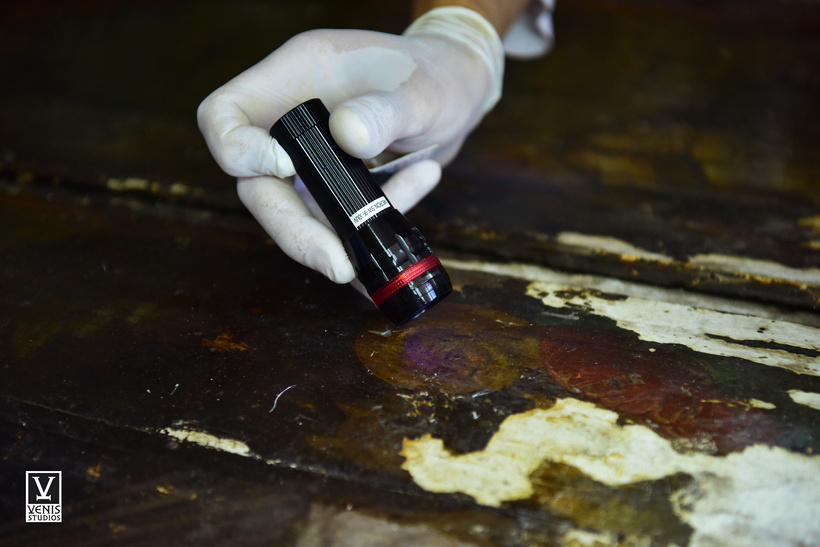
©VENIS STUDIOS
Conservation and Restoration Proposals are developed based on gathered information, outlining necessary treatments with prioritization based on urgency. A detailed Conservation and Restoration Plan is then created, specifying procedures, materials, and expected outcomes, along with a timeline and budget estimation. The entire process is compiled into a Documentation Report, serving as a valuable reference for conservators, researchers, and future caretakers, ensuring the icon’s comprehensive understanding and preservation for generations to come.
Conservation and Restoration Ethics
Ethical considerations are paramount, guiding conservators to strike a balance between intervention and historical authenticity. Ethical frameworks inform decisions, ensuring that conservation efforts preserve the icon’s integrity and cultural significance.
This comprehensive study delves into the intricate world of Christian Icons conservation and restoration, illuminating the diverse approaches employed by experts from various disciplines. By examining and analysing each potential examination method with precision and care, this research enhances our understanding of the multifaceted processes involved in preserving these sacred artworks. Through this meticulous exploration, we deepen our appreciation for the profound interplay between faith, artistry, and preservation, ensuring that these icons continue to inspire and endure for generations to come.
Ethical decision-making, rooted in conservation ethics and museum guidelines, ensures interventions honour the icon’s historical integrity and significance.
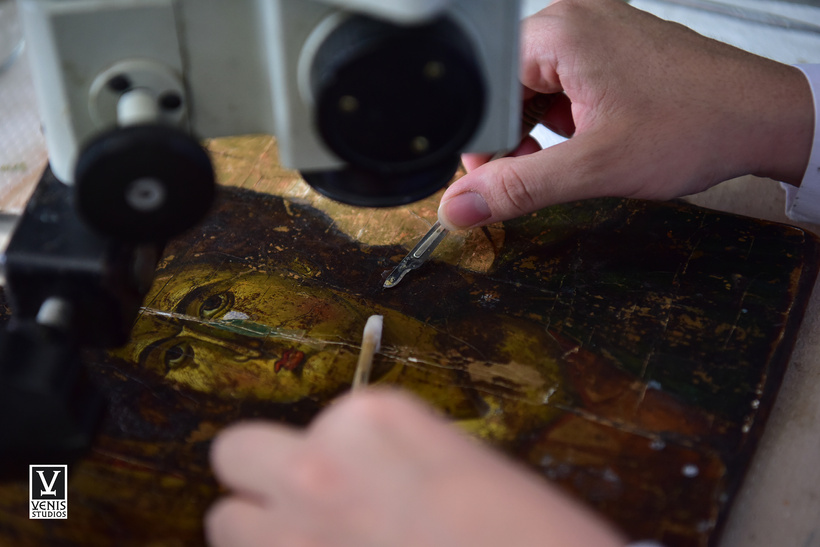
©VENIS STUDIOS
Comprehensive documentation and educational exhibitions, enrich the visitor’s experience and foster a profound appreciation for the icon’s heritage, highlighting the expertise of art conservators and restorers.
In the realm of professional Christian icon conservation and restoration, the expertise of art conservators and restorers serves as a beacon, preserving the soul of these artefacts. Every meticulous examination and treatment underscores the importance of entrusting these invaluable cultural treasures to professionals, ensuring their enduring legacy and cultural resonance. Through the dedication of these experts, these icons continue to inspire, educate, and resonate, embodying the rich tapestry of human history and spirituality.
The documentation methodology of an icon involves systematic recording, analysis, and preservation of essential information related to the artwork. This process is crucial for understanding the icon’s historical context, artistic techniques, condition, and any previous restoration work. Here’s a structured approach to documenting an icon
The Distinction Between
Art Creation and Art Conservation and Restoration
The process of generating new artistic creations involves the profound conception and skilful execution of a piece, typically undertaken by a trained artist. This dynamic journey is marked by expression, boundless creativity, and groundbreaking innovation, with the central objective being the production of something novel and unparalleled. This domain is inclusive, welcoming participants from all walks of life, regardless of formal art education, providing an avenue for individuals to channel their imagination and creativity.
However, labelling the attempt to superimpose “art creation” onto historical masterpieces as “restoration work” by amateurs, students, or non-professionals is considered forgery—a condemnable cultural offence subject to legal prosecution. Such actions undermine the integrity of cultural heritage and tarnish the authenticity of artistic legacies, warranting serious consequences within the legal framework.
In stark contrast, the domain of art conservation and restoration addresses pre-existing historic artworks that may suffer from damage or decay. The objective is not to generate something new but to safeguard and, when necessary, meticulously repair an already existing historic piece. This task demands a profound comprehension of art history, materials, and techniques, coupled with an unwavering commitment to preserving the authenticity and integrity of the original work. The successful execution of this delicate process necessitates the fusion of art and science, a task entrusted solely to seasoned professionals—expert art conservators and restorers.
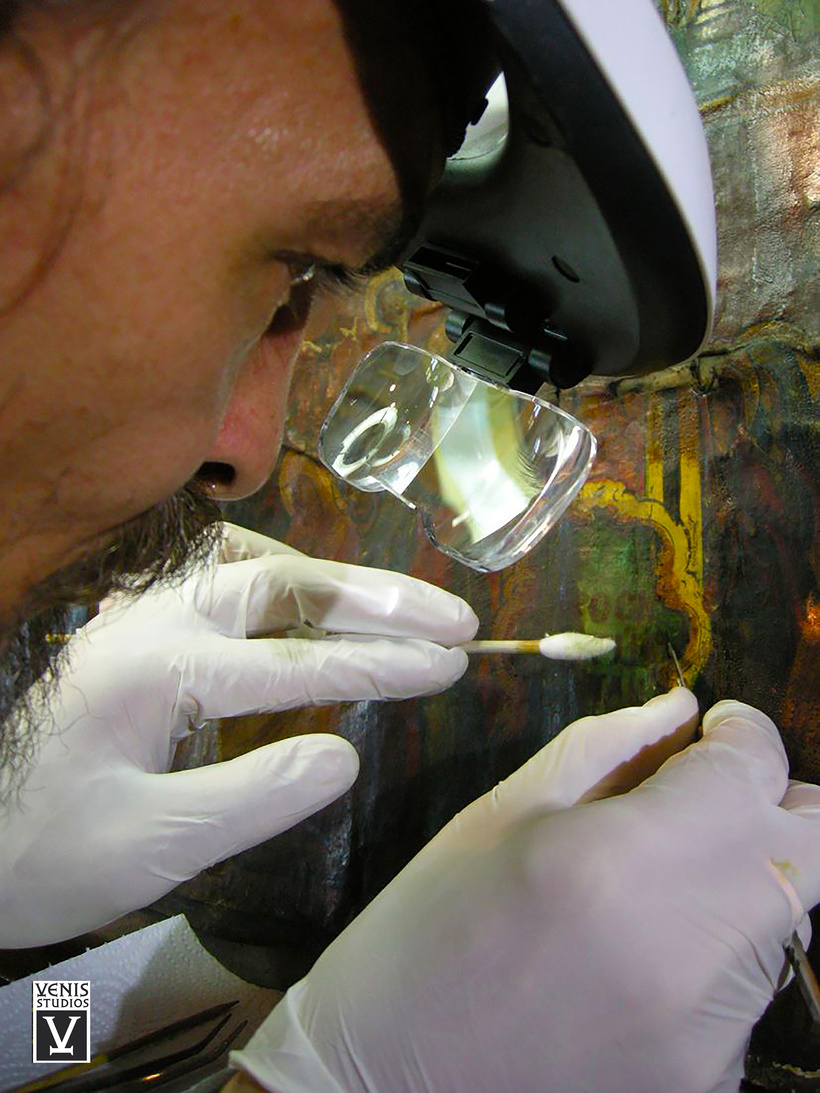
©VENIS STUDIOS
Preserving the Sacred Legacy of Christian Icons
In the intricate tapestry of religious and artistic heritage, Christian icons stand as enduring symbols of faith, spirituality, and human creativity. The journey through the history, symbolism, techniques, and conservation of these sacred artworks reveals the profound interplay between religious devotion, artistic ingenuity, and the thorough efforts of conservators and restorers.
Christian icons, rooted in centuries of tradition, transcend mere artistic expression; they embody the essence of religious beliefs, conveying profound theological messages to believers and art enthusiasts alike. Through their vibrant colours, intricate details, and timeless symbolism, icons serve as windows to the divine, fostering spiritual contemplation and deepening the connection between worshipers and the sacred figures they represent.
The historical evolution of Christian icons, from their early origins in catacomb paintings to the Byzantine period and beyond, reflects the dynamic intercultural exchanges and diverse artistic expressions that have shaped their significance. The symbolism embedded in each stroke of the artist’s brush or each carefully chosen pigment adds layers of meaning, inviting viewers to delve into the rich narratives of faith, sacrifice, and divine grace.
The conservation and restoration of these invaluable artefacts require more than just technical expertise; they demand a profound sensitivity to the cultural, religious, and historical contexts that define these icons. Professional art conservators and restorers, armed with a deep understanding of materials, techniques, and ethical considerations, play a pivotal role in ensuring the icons’ authenticity and spiritual significance endure the ravages of time.
The detailed examination and analysis methods, ranging from visible light examination to advanced spectroscopic techniques, provide conservators with invaluable insights into the composition, condition, and historical context of icons. Through these methods, conservators unveil hidden details, decipher artists’ intentions, and unravel the layers of history contained within each icon. Ethical decision-making serves as the guiding light, ensuring that interventions honour the icon’s historical integrity and significance, striking a delicate balance between preservation and intervention.
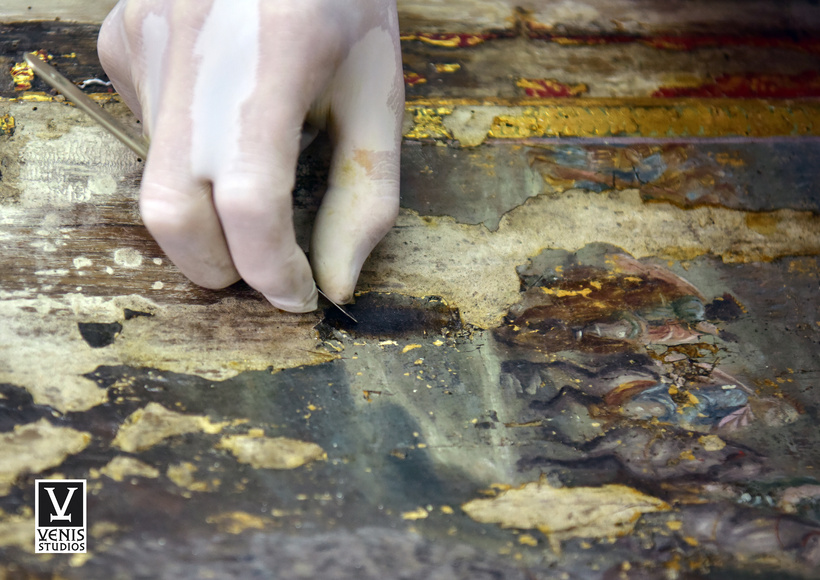
©VENIS STUDIOS
Furthermore, the comprehensive documentation of icons, encompassing historical research, visual examination, material analysis, and conservation proposals, creates a robust foundation for their preservation. These detailed records serve as invaluable resources for conservators, researchers, and future caretakers, fostering a deeper understanding of these sacred artefacts and enriching the cultural and artistic discourse surrounding them.
In the realm of professional Christian icon conservation and restoration, the expertise of art conservators and restorers shines brightly, preserving not just the physical form but the soul of these artefacts. Through every meticulous examination, thoughtful analysis, and delicate restoration, these experts ensure that Christian icons continue to inspire, educate, and resonate across generations. As bridges between the earthly and divine realms, these icons weave a timeless narrative of faith, artistry, and cultural heritage, reminding the world of the enduring power of spiritual expression through the medium of art.
In essence, the conservation and preservation of Christian icons is a sacred endeavour, a harmonious blend of art, science, and devotion. Through the dedication and expertise of those entrusted with their care, these icons continue to radiate their divine light, illuminating the path for generations to come.
I want to learn more:
Edited Athina Gkouma
About the author:
Venizelos G. Gavrilakis, a renowned expert in the art conservation and restoration of Byzantine and post-Byzantine icons, historical oil paintings, and Ottoman-era artwork, has been working as a senior expert conservator and restorer since 1994. He has worked with various institutions and has been involved in international conservation meetings and conferences. Gavrilakis is the president of the art conservation and restoration company VENIS STUDIOS, based in Istanbul, Turkey, and has collaborated with galleries, antique dealers, and private collectors.
-
Articles: World Art News articles
-
Interview: Preserving The Past, Embracing The Future: An Interview With Venizelos Gavrilakis, President Of Venis Studios conservation
Our related articles

